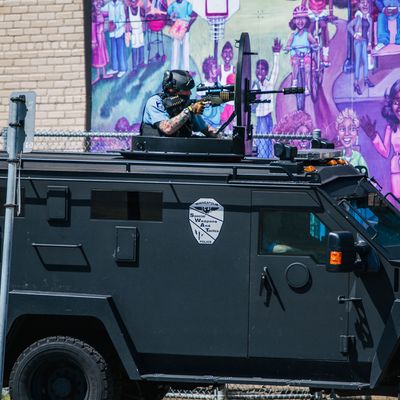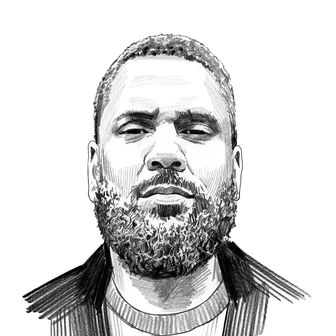
Of all the election results from Tuesday, the defeat of Ballot Question 2 in Minneapolis was the clearest indication of where we are, as a country, on what to do about cops after George Floyd’s murder. Minneapolis was Floyd’s hometown, after all, where rioters set a police precinct on fire in May 2020 — only to have 54 percent of respondents to a Monmouth University poll say their actions were partially or fully justified. If bold change was possible anywhere, it was here.
And yet, nobody was able to make good on that radical moment’s big policy commitment: a pledge, made by a nine-member City Council majority that summer, to disband the Minneapolis Police Department and replace it with a more comprehensive public-safety apparatus. Now, 18 months later, local activists and organizers are reeling from a decisive 56-44 drubbing at the polls.
Supporters looking for a silver lining in Tuesday’s loss are flirting with sunny naïveté — what might be called the Lloyd Christmas approach to politics (“So you’re telling me there’s a chance!”). A 12-point split is big. But considering how forcefully much of the nation’s political mood has swung back toward pro-cop sentiment in the last year and a half, it’s objectively remarkable that 44 percent of Minneapolis voters were still onboard with such a dramatic reconsideration of public safety.
The primacy of policing in the Twin Cities remains intact, and defunding and abolishing the cops still looks like an electoral loser in most places. But even in defeat, the Ballot Question 2 result hints at a hunger for change that’s closer in spirit to what abolitionists want than the anodyne reforms being offered by their detractors.
This was especially significant given how unclear much of the measure was and how badly it was demagogued. The amendment, had it passed, would have meant replacing the police department with a new “public health”–oriented Department of Public Safety, the functions of which would’ve been determined by the mayor and the City Council. It would have included police officers “if necessary” — a good indication that the cops probably weren’t going anywhere, even if there might’ve been slightly fewer of them, since a minimum staffing-level requirement that’s been in the city charter since the 1960s would have been eliminated.
This was certainly not, at least in the form it took on the ballot, a decisive move to get rid of the police. Still, this is how Mayor Jacob Frey characterized it — “the movement [to defund the police] has been roundly rejected,” he said of his reelection victory — and how many voters seemed to perceive it: “We need the police,” one told the Minneapolis Star Tribune of his decision to vote “no.” The amendment’s most extreme feature was arguably its vagueness. ”You’re voting for whatever they [the mayor and the council] want to do,” another worried voter said.
Opposing a blank check for the city’s government is rational, to be sure. And yet, even with this broad characterization of Question 2 as essentially a “free pass” to get rid of the cops, a little less than half of Minneapolis voters basically said, “Sure.”
There are caveats to what might be gleaned about overall public sentiment here. The leanings of 44 percent of voters in an off-year election where a little over 140,000 ballots were cast aren’t broadly illustrative, and we don’t know how much of the “yes”-vote share was driven by real ideological commitment, misperception, or what. And of course, it’s worth noting again that this measure lost, and seems to have lost by a margin that would have any political rival happily kicking up their feet with a flute of Champagne.
But at the same time, so much of the course-correction we’ve seen around policing since the summer of 2020 — from once tentatively pro-“defund” local officials, including several in Minneapolis, ditching the issue once election season rolled around, to the dissolution of congressional police-reform talks into a massive cop-hiring push by the White House — has been explained by the notion that basically no one actually wants this stuff. Contrary to what the summer of Floyd seemed to portend, “people” are clamoring for more and better-funded cops, not a systemic revamp.
And indeed, according to most polling, majority opinion is still squarely status quo. But if I’m someone who cares about public safety and sees the police as fundamentally destructive, and wants to help organize my neighbors accordingly, I’m looking at these Minneapolis numbers — 44 percent! — and wondering if it’s not actually more complicated than that.
It’s easy to forget how different things are now compared to less than a decade ago. Broadly speaking, we’ve gone from being a culture that was largely in the dark about the persistence of police abuse — and generally assumed, whenever news of it surfaced, that the cops were right and their victims deserved whatever they got — to a substantially more skeptical one. In the last five years alone, we’ve seen huge double-digit swings — including among conservatives and white Americans, usually among the most pro-cop cohorts — in public opinion about whether the criminal legal system needs to be overhauled, and how forcefully the police need to be reined in. We went from being a country where police violence tended to come and go with little fanfare to one where it’s more often pointedly scrutinized in the context of the largest social movement in U.S. history — one that also prompted a nation-spanning spate of insurrectionary violence.
I’m on record as being generally bearish about the durability of the George Floyd protests and the prospective changes they put on the table. Too many of the social conditions that informed them seemed fleeting, and now that several of those conditions have lost their salience — including many of the toughest restrictions wrought by the pandemic and the presence of Donald Trump in the White House — that skepticism has been largely borne out. In this light, it’s easy to conclude, perhaps correctly, that advocates who wanted big change missed their moment. The possibility of a new public-safety apparatus in Minneapolis might’ve been possible once, but it got squandered by poor framing, shoddy construction, and a general lack of preparedness for how far so many everyday people would be open to going, and then how fickle their conviction would be.
But if there’s one thing we can be sure of, as plenty of more moderate reforms are alternately adopted and discarded across the country, it’s that the police violence that got people into the streets after George Floyd’s murder isn’t going away, and in all likelihood will persist at similar rates as before. The rage that led to that fleeting summer of 2020 energy will be back, and it would behoove everyone to get ready for next time.






























